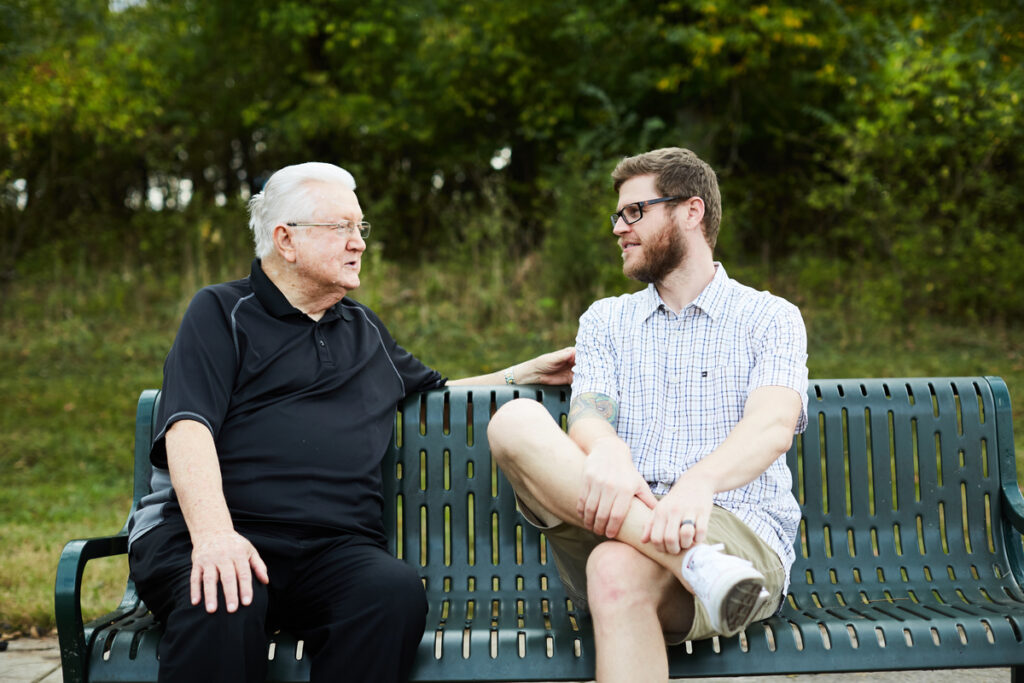“We do not want merely to see beauty, though, God knows, even that is bounty enough. We want something else which can hardly be put into words — to be united with the beauty we see, to pass into it, to receive it into ourselves, to bathe in it, to become part of it.”[1]
― C.S. Lewis, The Weight of Glory
In the first part of this series, I explored how genuine acts of persuasion are always built on shared concepts of the good, the true, and the beautiful. I argued that, because of God’s Common Grace, all humans can understand these “transcendentals,” at least to some extent. This changes the way we engage in Christian persuasion; it opens additional avenues of discussion beyond rational syllogisms and analytical arguments. In the second part of this series, I explored how Christian morality can support the vast metaphysical claims of the Christian faith. The truth of Christianity is underwritten by the difference it makes in individual lives and community structures.
In this article, I will explore the significance of the transcendental that—I believe—is most often ignored in the modern practice of Christian persuasion: beauty. While truth and goodness are commonly invoked in modern discourse, beauty is often ignored or minimized. Part of this, as we will explore below, is due to the rise of “modernity.” In general, modernity has taught people to believe that the most important facts about reality are those which can be measured and quantified. Truth claims can often be measured and claims surrounding morality can be quantified based on the impacts they have on others. Our experience of beauty, though, has been relegated to inconsequentiality by this mechanistic, modern frame.
Under the surface, however, competing conceptions of beauty are often powerfully operating in ways that Christian apologists rarely acknowledge. Overlooking the significance of beauty short-circuits Christian persuasion, and it undermines one of the most compelling aspects of Christianity. People have been sounding the alarm bells on the modern propensity to ignore beauty for years now: Charles Taylor has warned us against “disenchantment,” Philip Reiff has warned us about the destruction of “sacred order,” and Robert Bellah has highlighted the destruction brought about by purely individualized accounts of the beautiful life.
What is beauty?
When you first hear the word “beauty,” your thoughts may intuitively jump toward sweeping natural vistas or classic paintings. Perhaps you think of exceptional cinematography, striking architecture, or unmatched orchestral performances. Often, visual categories of beauty are the easiest for us to conceptualize, followed closely by auditory forms of beauty. Many of us, while not using the word beauty to describe it, can also relate to the unmitigated enjoyment that comes from eating our favorite foods—a good medium-rare steak for me! While part of that enjoyment may be found in simply satisfying hunger—the underlying need that the food solves—a great deal of the enjoyment is simply due to the taste, texture, and temperature of the food in question.
Many of us find certain times of the year to be beautiful. We plan for them, long for them, and spend a great deal of our life anticipating their arrival. I love Thanksgiving and its associated turkey, stuffing, and family bonding. I often find myself reminiscing about Thanksgivings of the past: brisk mornings, family football, movie marathons, and wonderful food. Even memories can be beautiful!
Beyond these sensory forms of beauty, many of us intuitively understand how a story can be captivating. Above all others, the story of the Gospel teaches us what beauty is and draws us into a beautiful account of reality. An account of reality that affirms we are fully known and fully loved by a God who is actively involved in our lives and sent his own Son to die for us.
Why does beauty matter for Christian persuasion?
The examples of beauty above share a few similarities: in various ways, they affect us deeply, draw us out of our complacency, motivate us toward some end, and give us something to enjoy. St. Augustine famously explored the powerful impact of beauty on the human psyche when recounting the story of his salvation:
Late have I loved you, O Beauty ever ancient, ever new, late have I loved you! You were within me, but I was outside, and it was there that I searched for you.…You called, you shouted, and you broke through my deafness. You flashed, you shone, and you dispelled my blindness. You breathed your fragrance on me; I drew in breath and now I pant for you. I have tasted you, now I hunger and thirst for more. You touched me, and I burned for your peace.[2]
For Augustine, his salvation experience was not a purely rational affair. He didn’t simply evaluate various academic proofs for God’s existence or the evidence for the resurrection of Jesus Christ; he was instead overcome by the “fragrance,” “taste,” and very voice of God. This is not to say that Augustine’s salvation was only due to the operations of beauty; no, Augustine additionally engaged both his rationality and moral sense all throughout his conversion account. Beauty, though, played an important role in his conversion.
Like Augustine before him, C.S. Lewis credits the operations of beauty as a pivotal piece of his conversion to Christianity. He argues that his “imaginative life” warred against the life of his intellect. “On the one side a many-islanded sea of poetry and myth; on the other a glib and shallow ‘rationalism’. Nearly all that I loved I believed to be imaginary; nearly all that I believed to be real I thought grim and meaningless.”[3] It was thanks to this dissonance that Lewis broke free of his naturalism. In a naturalistic account of our universe, beauty is a figment of the mind. In a Christian account of reality, beauty reflects God.
Jonathan Edwards argued that it is God’s beauty which “will melt and humble the hearts of men, and wean them from the world, and draw them to God, and effectually change them.”[4] This is because it is ultimately beauty that motivates humans. Without beauty, truth and goodness both lose something vital. As Hans Urs von Balthasar explains, beauty underwrites the other transcendentals by providing a path through which they can break into our human experience.
In a world … which is perhaps not wholly without beauty, but which can no longer see it or reckon with it: in such a world the good also loses its attractiveness, the self-evidence of why it must be carried out. Man stands before the good and asks himself why it must be done and not rather its alternative, evil… In a world that no longer has enough confidence in itself to affirm the beautiful, the proofs of the truth have lost their cogency. In other words, syllogisms may still dutifully clatter away like rotary presses or computers which infallibly spew out an exact number of answers by the minute. But the logic of these answers is itself a mechanism which no longer captivates anyone.[5]
Beauty is what enchants our lives, and it is true beauty that makes the hearts of humans delight in goodness and truth. It is imperative that Christian apologists attend to beauty and help others see the beauty of the Gospel.
However, just like our human understandings of what is good and true can often be flawed, our understanding of what is beautiful can fall woefully short of reality. Hollywood has made an entire industry out of packaging and selling a variety of “beautiful” stories—with many of these stories containing mutually contradictory visions of a beautiful life. Some stories paint gratuitous violence as praiseworthy, others gratuitous sexuality. Herein lies one of the major reasons that beauty has become unpopular as a motivating source in contemporary discourse: our visions of beauty can be wrong, and there aren’t always easy paths toward correcting them.
The Powerful Impacts of Beauty
Perhaps a very practical example of the power of beauty in our modern lives might drive home this transcendental’s significance. Jonathan Haidt’s recently published book, The Anxious Generation, details how a distorted vision of beauty can cause intense harm. Haidt argues that the sudden increase in anxiety and mental health challenges in Gen Z is tied, at least in part, to social media and smartphone use. He points out how young women are particularly vulnerable to rising rates of depression and self-harm due to the beauty standards that are being propagated and encouraged through social media. Beauty, in this digital age, is being increasingly tied to one’s digital footprint, and that digital footprint is subject to manipulation at the hands of high-tech filters and selection bias.
In short, people only post the highlights of their lives on social media, and they post those highlights with artificial improvements baked in. The litany of images, stories, and portrayed ways of life that are then promoted through social media are fundamentally disconnected from the everyday lives of most people. These accounts reshape the definition of beauty for those observing. It isn’t just the physical standards of beauty that gets reshaped through social media; it is also the emotional and experiential standards of beauty as well. If every story someone sees on their phone involves happy people doing incredible things in incredible places, their baseline expectations for a beautiful life become disconnected from reality. Is it any wonder, Haidt argues, that young people’s rates of depression and self-harm have skyrocketed since their visions of beauty have been hijacked?
In addition to these unrealistic standards, Haidt argues that the phone-based life undermines many of the practices that have historically helped humans cope with anxiety and depression. The internet age is rewiring our conception of a beautiful daily rhythm; we are growing increasingly tied to the instantaneous delivery of data, controversy, and dopamine that phones offer. Haidt, himself not a Christian, argues that this rewiring has harmed the spiritual health of our society. Quoting Blaise Pascal, Haidt provocatively suggests that our digital age is attempting to fill the “God-sized hole” in our lives with cheap counterfeits.[6] Inevitably, the false beauty being offered is unfulfilling. And it is to this resulting malaise, which Christians should learn to diagnosis therapeutically. For the problem is not the pursuit of beauty but the idolatrous substitution of imitations.
Toward Filling the God-sized Hole
The modern world does not only need Christian apologists defending the core truth claims of Christianity (though it certainly does need that!), but it also needs Christian apologists who are able to invite people into the beauty and drama of the Christian life. This involves weaving all three transcendentals together into a cohesive and compelling account of the Christian story. It involves modeling the kind of life that exemplifies Christian ethics, and it involves narrating to others what we personally see as most beautiful aspects of the Christian life. Just as social media is offering young people countless visions of a beautiful life and fundamentally reshaping their conceptions of beauty, Christian apologists can offer compelling accounts of Christianity’s beauty, over and against the unfulfilling visions of beauty that the secular world is offering.
Due to God’s Common Grace, all humans can glimpse and appreciate real beauty. A story showcasing familial love can capture anyone’s heart; forgiveness freely offered can soften even the angriest of people. Literary classics like The Lord of the Rings can help all of us value courage, and musicals like Les Misérables can teach all of us that grace is truly precious. While competing visions of beauty can often complicate Christian witness, no one’s vision of beauty is wholly void of some reference to real beauty. Secular scripts of beauty are not entirely disconnected from Christian accounts of beauty, and Christian witness can have powerful impacts in the realm of beauty, especially as it offers us a way to invite our neighbors into a way of life that is more full, hopeful, and exciting.
In the final entry of this series, I will explore some practical ways to offer this kind of Christian witness, including ancient Christian practices that help reframe our own understanding of beauty.
Notes:
[1] C. S. Lewis, The Weight of Glory and Other Addresses, 1st HarperCollins ed., [rev.] (San Francisco: Harper Collins, 2001), 42.
[2] Augustine, Confessions, trans. Maria Boulding and John E. Rotelle, The Works of Saint Augustine, I/1 (Hyde Park, NY: New City Press, 2012), X.38.
[3] C. S. Lewis, Surprised by Joy: The Shape of My Early Life (San Francisco: HarperOne, 2017), 209-210.
[4] Jonathan Edwards, Religious Affections, (New Haven, Conn.: Yale Univ. Press, 2009), 264.
[5] Hans Urs Von Balthasar, The Glory of the Lord: Volume I: A Theological Aesthetics: Seeing the Form, ed. John Riches (T&T Clark Ltd, 1982), https://doi.org/10.5040/9780567690944, 18.
[6] Jonathan Haidt, The Anxious Generation: How the Great Rewiring of Childhood Is Causing an Epidemic of Mental Illness (New York: Penguin Publishing Group), 215-216.
Published October 23, 2024




